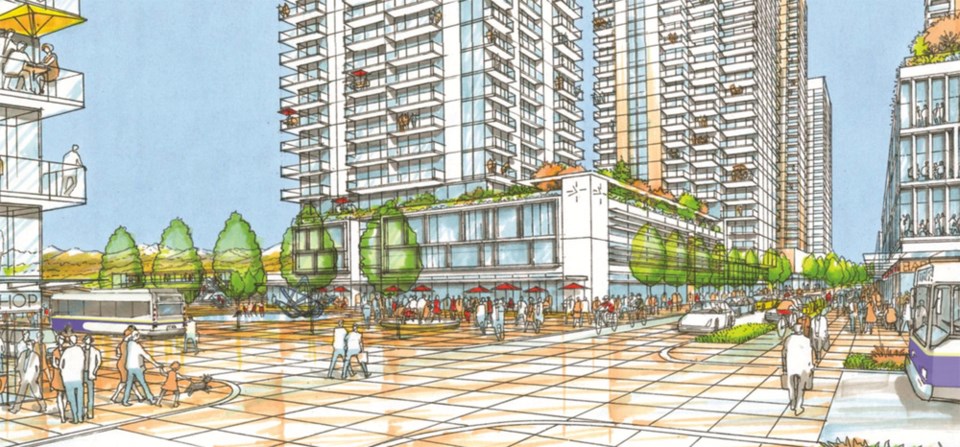A consortium of nine property owners and developers will have to sharpen its pencils to find more green space and jobs — and less density — if its plan to transform 23 acres of light industrial and commercial space around the Moody Centre SkyTrain station is to be realized.
But there was enough Port Moody councillors did like in their first real look at the proposal's latest iteration during Tuesday’s meeting of committee of the whole for them to recommend the proponents continue working with city staff and consideration of council's suggestions to refine their plans, including a detailed financial analysis.
Otherwise, said Port Moody Mayor Rob Vagramov, he’d be just as happy to let the neighbourhood stay the same with “more hookah lounges there, more Subways.”
That would be a shame and wasted potential, countered Ryan Bragg, a principal for the project’s architecture firm Perkins+Will.
He said the construction of a dense, urban community — of up to 4,135 homes, spaces for approximately 2,000 jobs, a 1.75-acre public plaza, along with several pocket parks along a pedestrian- and cyclist-oriented Spring Street that would form the project’s “backbone” — presents the city an opportunity to becoming a destination.
“People will come to see this part of Port Moody because it’s different,” Bragg said, adding the narrowness of Spring Street lends itself to creating a unique urban vibrancy that’s hard to replicate outside major metropolises.
Bragg said the neighbourhood — bounded by the SkyTrain tracks and St. Johns Street to the north and south, and Moody Street and Electronic Avenue to the west and east — is in “desperate need of a new identity.” And the consortium has been formulating just that — in consultation with city staff — for three years.
But several councillors said replacing the existing hodge-podge of auto-body shops, strip plazas and small, empty warehouses with gleaming condo towers up to 36 storeys is not the kind of identity the city needs, or desires.
“The scale of this development isn’t what Port Moody is looking for,” said Coun. Steve Milani.
“I think this is too dense,” Coun. Meghan Lahti added. “There’s too many towers and not enough green space.”
Others said they wanted to see more benefits to the community in exchange for the amendments to the city’s official community plan (OCP) that would be necessary for the project to proceed.
“I like the amenities but I think there should be more,” Lahti said. “It’s a start.”
Bragg said that start already amounts to about $135 million.
It includes:
• five pocket parks along Spring Street where people can meet
• an urban plaza at the entrance to the SkyTrain station that could become a gathering place for community events
• a new pedestrian overpass to link Moody Centre to Rocky Point Park
• and the daylighting of about 150 metres of Slaughterhouse Creek that bisects the site
As well, 400 to 450 of the project’s residential units would be rented at below-market rates and another 300 to 385 would be market rental apartments while its commercial and retail component would provide employment for approximately 2,000 people.
In his report, André Boel, Port Moody’s general manager of planning and development said the proposal is “largely consistent” with the city’s growth management objectives: It provides more employment spaces, benefits the local environment and addresses the city’s climate action plan by reducing car dependence as it prioritizes pedestrian and cycling mobility.
But Coun. Hunter Madsen took issue with the proponents’ plan for managing traffic. He said an assertion by traffic consultant Peter Joyce that commuters passing through the city would change their behaviour as the St. Johns Street corridor gets busier is “just replacing the congestion with our own congestion.”
Coun. Zoe Royer said she’d like to see increased job opportunities in the neighbourhood, so Port Moody can get closer to attaining its goal of having more residents be able to live and work in the city.
“I see this as a central business district,” she said.
Still, cautioned Coun. Diana Dilworth, it’s early days.
“We have to be cognizant that building technology is going to change, transportation is going to change, other developments have all changed for the better over time,” she said. “Let’s not throw the baby out with the bathwater.”



